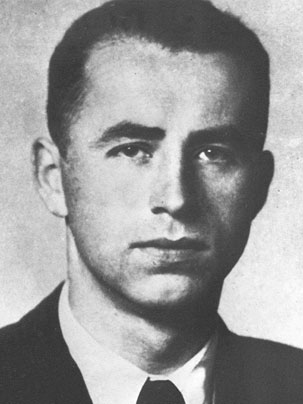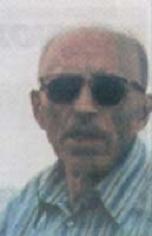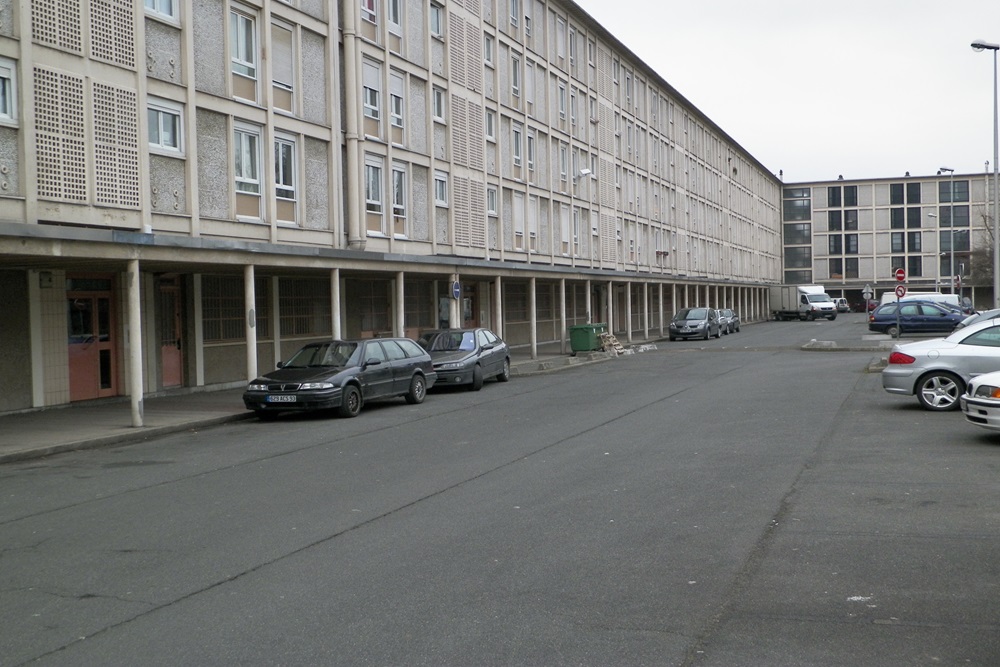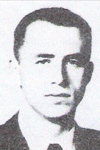Introduction
Up to 2014, Alois Brunner was the most wanted Nazi war criminal. During World War Two, he was Adolf Eichmann’s closest associate and responsible for the deportation of tens of thousands of Jews to the extermination camps in Poland. In December 2005 it was assumend he was on holiday in Switzerland but he could not be tracked down.
Right hand man of Eichmann
Alois Brunner was born April 8, 1912 in Rohrbrunn, a little town in the Austrian province of Burgenland, son of the farmer Joseph Brunner and his wife Anna Brunner Kruiss. Alois attended school from 1918 to 1927, first the Volksschule (primary school) and later the Bürgerschule (secondary school). Next he graduated from trading school and he worked at various jobs such as salesman until 1932. May 29, 1931, he joined the Austrian branch of the NSDAP (National socialist German Workers Party) and on December 6, 1931 he joined the SA, causing him to lose his job in the department store where he worked.
After the Anscluß, the annexation of Austria by Germany on March 12, 1938, he joined the SS on November 15, 1938. In Vienna, he went to work for Adolf Eichmann, head of the Zentralstelle für Jüdische Auswanderung (Central Jewish Emigration Office). This office occupied itself with putting the Jewish community under pressure and so stimulating the Jews to emigrate from Austria. First of all Eichmann and his associates assembled all Austrian Jews in Vienna. An emigration quota was set and the Jewish community was subsequently ordered to meet this quota. The Jews were to pay for their emigration themselves and the richer Jews were to pay for the emigration of the poorer. Eichmann’s office charged high fees for emigration permits and in addition, the possessions the Jews left behind were confiscated, hence Eichmann’s Zentralstelle was a very lucrative enterprise for the SS.
Within the Zentralstelle, Brunner evolved into Eichmann’s right hand man. After the outbreak of war in September 1939, Brunner organized the deportation of Jews from Vienna and Moravia to Nisko in Poland in November and December. Around that time, Adolf Eichmann and Franz Stahlecker were working on the Nisko and Lublin plan which meant that Jews would be assembled in a transit camp in Nisko and subsequently be deported to the region of Lublin in the General Government in Poland. Here, a Jewish reservation under German rule was to be established. In 1940 though, the plan was abandoned and the camp in Nisko was closed down.
On January 1, 1941, Brunner succeeded Eichmann as chief of the emigration department in Vienna. In December 1939, Eichmann had been appointed chief of Referat IV D, a department within the RSHA which was responsible for Räumungsangelegenheiten - eviction – and Jüdische Auswanderiung (emigration). Meanwhile, emigration policy had been changed into a deportation policy as the Jews were being forcibly transferred to ghettoes in the east from where they would eventually be deported to the extermination camps. In addition, emigration was forbidden for Jews as from October 1941. In July, about 50,000 Jews were still living in Vienna and Brunner was ordered to remove them all. A large number of these Jews was deported to the extermination camps and others ended up in the ghettoes in the east. On October 9, 1942, Brunner could inform Eichmann, to the great satisfaction of the latter that Vienna was Judenfrei (free of Jews). Brunner had proved himself a gifted organizer and from 1942 onwards, he was deployed by Eichmann on locations where deportations of Jews faltered.
Definitielijst
- Jews
- Middle Eastern people with own religion that lived in Palestine. They distinguished themselves by their strong monotheism and the strict observance of the Law and tradition. During World War 2 the Jewish people were ruthlessly persecuted and annihilated by the German Nazis. . An estimated 6,000,000 Jews were exterminated.
- Nazi
- Abbreviation of a national socialist.
- RSHA
- Reichssicherheitshauptamt. The central information and security service of the Third Reich.
Images
Solver of problems and war criminal
As emigration was no longer used as a means to solve the Jewish question, Eichmann’s Referat within the RSHA became responsible for Juden- und Räumungsangelegenheiten. Due to a reorganization, Eichmann’s department was transferred to Referat IV B 4. Being an associate of this department, from October 1942 until January 1943, Brunner kept busy deporting Jews from Berlin. When the German capital was declared free of Jews in June 1943, Brunner was active elsewhere in the meantime.
In February 1943, Eichmann dispatched Brunner to the Balkans where he was to take charge of the deportation of Jews from Macedonia and Thracia. Both territories –Thracia only partially – were annexed by Bulgaria, an ally of Germany. The major task Brunner had to take on was the deportation of the large Jewish community from the city of Thessalonica (also known as Salonica), the Macedonian capital. Two thirds of the Greek Jews were living in the city, amounting to some 50,000. In collaboration with his colleague, SS-Hauptsturmführer Dieter Wislicency and Kriegsverwaltungsrat Dr. Max Merten, representative of the regional military administration, he set up the deportation of Jews from Thessalonica in the meanwhile tried and tested manner. First, the Jews were obliged to live in a ghetto and to wear a yellow star on their clothes. In addition, a Jewish Council was set up whose members, all Jews, which was to act as liaison between the Jewish community and Brunner and his colleagues. Within two months, almost the entire Jewish community of Thessalonica including pregnant women, mothers, children, the elderly and the sick, were deported to Auschwitz in freight trains.
Brunner’s last action took place in Bratislava, the Slovakian capital. In August 1944, a people’s revolt against the Nazis had erupted here. In reaction to the uprising, the Germans occupied the country. Brunner was dispatched to Bratislava to deport the remaining Jews. In the end, 12,000 to 14,000 people were deported to Auschwitz, Sachsenhausen and Theresienstadt. In addition, hundreds of Jews were murdered by the Germans on the spot. When the Russians entered Bratislava on April 4, 1945, there were some 15,000 Jews left in the country, including about 5,000 in hiding who had survived the slaughter.
Since the outbreak of the war, Brunner has been responsible for the deportation of tens of thousands of people, for instance to extermination camp Auschwitz. A sizable number of these deportees did not survive the war. Brunner is held accountable for the deportation and murder of a total of 120,000 to 130,000 people: 43.000 from Austria, 46.000 from Greece, 24.000 from France and 13.500 from Slovakia. According to Nazi hunter Simon Wiesenthal, Eichmann had drafted the overall plan for the extermination of the Jews and Brunner has executed these plans. Wiesenthal designated Eichmann and Brunner as "two equally large stars on the firmament of death".
Definitielijst
- collaboration
- Cooperation of the people with the occupying forces, more generally spoken the term for individuals who cooperate with the occupying force is collaborator.
- ghetto
- Part of a town separated from the outside world to segregate Jewish population. The establishment of ghettos was intended to exclude the Jews from daily life and from the rest of the people. From these ghettos it was also easier to deport the Jews to the concentration and extermination camps. Also known as “Judenviertel” or Jewish quarter.
- Jews
- Middle Eastern people with own religion that lived in Palestine. They distinguished themselves by their strong monotheism and the strict observance of the Law and tradition. During World War 2 the Jewish people were ruthlessly persecuted and annihilated by the German Nazis. . An estimated 6,000,000 Jews were exterminated.
- Nazi
- Abbreviation of a national socialist.
- RSHA
- Reichssicherheitshauptamt. The central information and security service of the Third Reich.
- Theresienstadt
- City in the Czech Republic. Here the Nazis established a model concentration camp.
On the run
As the end of the war drew near, Brunner fled before the Red Army. It was the beginning of a period of almost 10 years wandering all over Germany to stay out of the hands of the authorities. In 1985, in a interview with the German weekly Bunte, he told exhaustively about his wanderings during his flight. It is difficult to verify his story and possibly he omitted certain issues in order not to betray possible helpers during his flight. In any case, his flight started in the Slovakian capital Bratislava where he had carried out his last assignment.
From Bratislava, Brunner left for Vienna in a staff car. As the Red Army was steadily approaching the outskirts of the city, he left for Prague. When he arrived on April 15, 1945, the city was still in Wehrmacht hands. Owing to the presence of Czech resistance fighters, Brunner did not feel safe here either. Dressed as a civilian, he left with a group of other Germans in westerly direction. In Bohemia, the western part of Czechoslovakia, he was arrested by the Czechs. Here he escaped death as many SS men were murdered by Czech partisans at the time. The SS men could be identified by the blood group tattooed on their arm but Brunner did not have that kind of identification.
In Pilsen, Brunner was extradited to the Americans. Here he took the name of a distant relative, Alois Schmaldienst. His identity was "confirmed" by a so-called acquaintance. Being a prisoner-of-war of the Americans, he was put to work in Munich as a driver. He was released in the summer of 1945 and while en route to his wife and children, he was arrested in Graz by the British. He was imprisoned once more. In the spring of 1946, he left the British PoW camp in Gratkorn. He subsequently found work as a farm hand for three months but he decided to return to Munich to work for the Americans again.
This time he worked for the Americans in Munich as a civilian driver. He illegally made money on the black market but the American MP found out in 1947. He decided to switch to another zone of occupation once more and he left for Hamburg on a fish transport. After a stay of only a few months in Hamburg he lived in Essen until 1951. Here he found employment as a miner and worked as a waiter in various pubs. Still in possession of American papers, a Personalausweis (ID card) and a Reisepaß, he decided to leave Germany with the intention to travel to Egypt. He counted on assistance by grand mufti Haj Amin al-Husseini, a former ally of the Nazis. Help from the mufti did not materialize however. There were few people who wanted to help Brunner. The words of Otto Skorzeny who had escaped to Spain himself, are clear enough about help for Brunner not forthcoming : "Für einen Schweinehund rühre ich keinen Finger." (I won’t move a finger for a bastard).
When his visa expired after three months, Brunner, after having been so advised by the grand mufti, departed to Syria. He found a home in Damascus and employment as an agent for Dortmunder Bier thanks to intervention by a member of the embassy. Later on he worked as an agent for the Bielefelder Textilmaschinenfabrik. He sent money to his wife who had stayed behind in Vienna. The monetary traffic between Vienna and Damascus was noticed by the Syrian secret service and in May 1960 he was picked up for questioning. When he revealed his real name, Alois Brunner and told them he was wanted internationally for war crimes, having been Eichmann’s former associate, they shook his hand, so he said. His interrogator would have said: "Die Feinde unsere Feinde sind unsere Freunde" (the enemies of our enemies are our friends).
He retained his false name and went to work for the secret service of the Syrian Arab Republic. Among other things, he gave lessons in German to employees of the secret service but in addition, he was probably involved in at least two actions against Israel. In 1961 he was allegedly involved in the planned bomb attempt against the chairman of the Jewish World Council in Vienna. The Austrian secret service managed to prevent this attempt. He is also said to have been involved in the plan to liberate Eichmann after his arrest. This rescue action proved impossible as Eichmann was kept prisoner in an inaccessible jail. With Eichmann’s lawyer, Dr. Robert Servatius, he also discussed possibilities to have his former boss released but without success. Eichmann was sentenced to death and executed in Jerusalem on June 1, 1962.
Definitielijst
- PoW
- Prisoner of War.
- Red Army
- Army of the Soviet Union.
- resistance
- Resistance against the enemy. Often also with armed resources.
- war crimes
- Crimes committed in wartime. Often concerning crimes committed by soldiers against civilians.
- Wehrmacht
- German armed military forces, divided in ground forces, air force and navy.
The hunt continues
Despite his whereabouts being unknown, Brunner was sentenced to death in Paris in 1954 and again in Marseilles in 1956. The French secret service SDECE had traced him in Syria though. In the 60s, a warrant for his arrest was issued in Austria, his native country and a request for extradition was made to Syria. The Syrians denied though that Brunner was in their country and the case was dropped. In 1977, a French diplomat reported Brunner was working for the Syrian secret service which protected him. Brunner again disappeared for a long time but between 1982 and 1984 he was found by Serge and Beate Klarsfeld, a French couple that tracked down fugitive Nazi war criminals. He still resided in Syria using the name Georg Fischer. In 1984 the public prosecutor of Rhineland-Westphalia applied for extradition but Syria refused to cooperate and continued to deny Brunner was living there.
Despite Syria’s refusal to extradite Brunner, the fugitive Nazi feared for his life. In 1961 he had lost his left eye when a package, addressed to him, exploded in the post office in Damascus. In July 1981, he received another bomb package. The device was hidden in a package from the "Verein Freunde der Heilkräuter" (friends of medicinal plants), a mail order firm in Austria from which he frequently received literature on homeopathy. He lost four fingers of his left hand. Both bombing attempts were almost certainly made by the Mossad, the Israeli secret service, although this has never been confirmed officially.
The press also managed to trace him. In 1985, the German weekly Bunte succeeded in nailing him for an interview in Damascus. Brunner declared to have no regrets for his actions and having had nothing to do with "those Jews in the east". He even stated the Federal Republic of Germany still owed him a small fortune in pension payments. A few years later, his interviewer stated Brunner was still proud of having disposed of these "dirty scoundrels". According to the interviewer, Brunner was even sorry there were still Jews living in Europe. Brunner’s chilling words led to protest among the victims of the Holocaust. In an interview by phone with the Chicago Sun Times in 1987, Brunner said: "The Jews deserved to die. I feel no remorse. Given the opportunity, I would do it all over again." Simon Wiesenthal considered Brunner without a doubt the worst of the Nazi criminals still alive of the Third Reich.
On March 2, 2001 a trial in absentia opened for the third time before a court in Paris against the then nearly 89-years-old Nazi. This new trial was made possible because new evidence was uncovered: the deportation of 241 Jewish children in late July 1944 from the Paris region to Auschwitz. Brunner was sentenced to life imprisonment but he had not been arrested yet. Applications for extradition by Israel, Germany and Austria have all been in vain. Even the request French president Jacques Chirac made to his Syrian colleague Hafez al Assad during his visit to Syria in 1996 to investigate the case was of no help whatsoever. In 1999 rumors erupted Brunner would have passed away in 1996. This was contradicted though by German journalists who claimed having met Brunner after that time in the Meridian Hotel in Damascus.
In 2005, the Brazilian police appeared to have traced the most wanted Nazi. Brunner, still using the name Georg Fischer, was said to live in Brazil from 1999 onwards. It was thought he had been on holiday in Luzerne, Switzerland in December 2005 but the Swiss police was only able to confirm a man named Alois Brunner was living in Luzerne but he was a 66-year-old Swiss civilian. It was unknown for a long time whether Brunner was still alive and in case he was, where did he live. In July 2007, the Austrian news agency APA reported Austria had offered a reward of € 50,000 for both former camp physician Aribert Heim and Alois Brunner. At the end of 2014, the Simon Wiesenthal Center struck him from the list of most wanted Nazis as it was presumed he had died of old age in Syria. His demise cannot be confirmed because of the war in that country.
Definitielijst
- Holocaust
- Term for the destruction of European Jewry by the Nazis. Holokauston is the Greek term for a completely burnt sacrifice.
- Jews
- Middle Eastern people with own religion that lived in Palestine. They distinguished themselves by their strong monotheism and the strict observance of the Law and tradition. During World War 2 the Jewish people were ruthlessly persecuted and annihilated by the German Nazis. . An estimated 6,000,000 Jews were exterminated.
- Nazi
- Abbreviation of a national socialist.
- Rhineland
- German-speaking demilitarized area on the right bank of the Rhine which was occupied by Adolf Hitler in 1936 after World War 1.
Information
- Article by:
- Kevin Prenger
- Translated by:
- Arnold Palthe
- Published on:
- 19-01-2025
- Feedback?
- Send it!
Related sights
Sources
- ARENDT, H, Eichmann in Jeruzalem, Atlas, Amsterdam, 2005.
- KNOPP, G., Hitlers moordenaars, Het Spectrum, Utrecht, 2004.
- SPECTOR, S. & ROZETT, R., Encyclopedie van de Holocaust, Kok, Kampen, 2004.
- Frauennews
- Jewish Virtual Library
- 'Meestgezochte nazi op vakantie in Zwitserland'
- Macedonian Press Agency
- Nieuw proces tegen nazi Alois Brunner
- Oostenrijk: prijs op hoofd nazi's - NOS
- Rechterhand Eichmann moet inmiddels dood zijn - NOS
- Simon Wiesenthal Center
- Wikipedia - Duits
- Wikipedia - Engels










